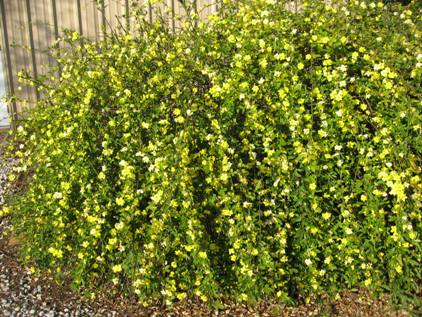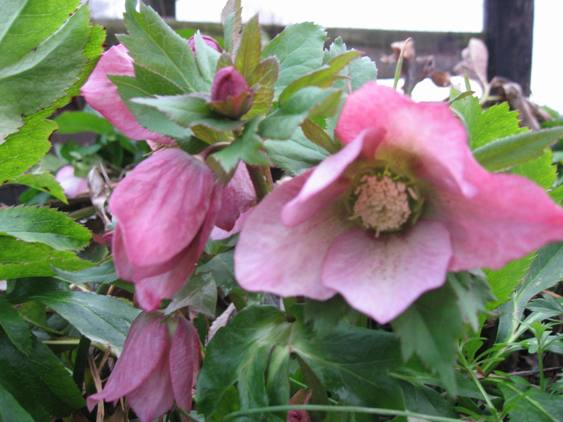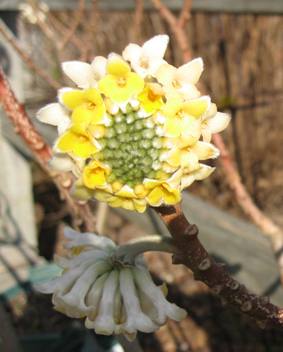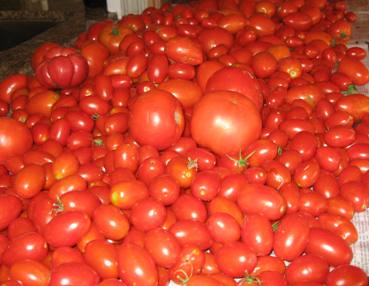Monthly Garden Gossip
February, 2012
Welcome to our garden! We're proud of our hard work and want to share the reward with you, so here is what's going on in the garden this month..Central Alabama
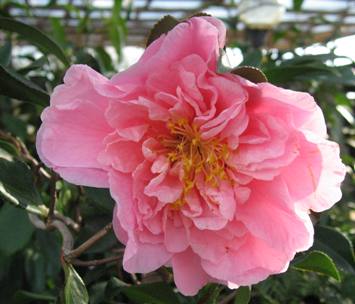 |
Camellia X vernalis Egao. Stunning pink flowers on contorted stems. A wonderful specimen plant. Flowers appear in late winter to early spring. Camellias must have an acid soil, well drained and free from extended freezes. Height 10 to 20 feet and width 5 to 12 feet. |
Winter Jasmine |
Lenten Roses |
| Winter Jasmine, jasminum nudiflorun, and Lenten Roses, Hellebores, are two plants that give great winter color. Both bloom very early in February. As you can see, the Winter Jasmine is a graceful arching shrub and the Hellebores are evergreen and have white, pink and burgandy flowers.There are several more such as Kiss-me-at-the Gate, lonicera fragrantissima, Paper Bush, Edgewworthia papyrifera, which by the way smells heavenly. Winter Daphne is also another very fragrant winter blooming shrub. Cotoneaster is a supberb shrub, evergreen in the south and loaded with bright red or orange berries that the birds love. Consider planting trees with interesting bark such as River Birch, Betula nigra, or Crepe Myrtles, Natchez, the white flowering one with the unmatched cinnamon bark. |
Edgeworthia |
PruningPrune crepe myrtles, Lilac Chaste trees and pomegrantes as well as other summer flowering shrubs such as summer flowering spireas, Annabelle, Peegee and Limelight hydrangeas and abelias. Muscadines should also be pruned this month. Begin pruning about mid February. Cut back all shoot growth of the previous summer to spurs with 3-4 buds. It is a good idea to remove old fruit stems since they are a source of disease. Remove the tendrils that wrap about the arms or spurs since they girdle the plant and reduce production. Remove the blooms from under camellias to help prevent petal blight. Prune boxwoods if needed. Open up from the inside to allow air circulation and light. Although most needled evergreens do not require regular pruning, if yours is getting out of hand now would be a good time to prune. Prune hollies and cotoneasters now. Give them some fertilizer when you are through. During winter there are certain precautions gardeners should follow to minimize potential problems with fruit plants. For example, don't apply pesticides (especially oil sprays), do any pruning (especially severe) or do any planting within 48 hours of a hard freeze (temperatures below 32 degrees F). Not following these rules can result in loss of fruit buds, branch damage or complete plant loss. |
SprayingIt is a good idea to start out with Dormant oil the last part of January and early February. It helps to control over-wintering insects such as mites and scale. Spray lime sulfur using a sticker spreader to all fruit trees when rain isn't predicted for 36 hours. Spray blueberries, blackberries and muscadines. Lime sulphur is a great clean up spray for over-wintering insects, mites and disease not only for your fruit plants but for all shrubbery and roses too. Copper sprays can be important for early disease control and are generally applied in February and March near early bud break. We use copper sprays on apples, pears, blackberries and sometimes on muscadines to reduce disease carry over. When lime sulfur, oil or copper sprays are being applied, always separate the different sprays by 2 to 3 weeks. Fire blight can be a problem on apples and pears. The best time to spray your trees for this disease is during bloom. Spray every 10 days with Streptomycin, sold as Fire Blight spray, to control this very damaging bacterial disease.
|
WeedsIf you have a weed problem now would be a good time to spray with a pre-emergent herbicide. This type of herbicide prevents the weed seeds from germinating thus reducing your weed population. However it has to be sprayed before the seeds germinate. If there are little weeds present already, you will have to use something to kill the weeds then spray the pre-emergent.
|
FertilizingMid-February we can begin to fertilize blueberries and pecans. For the pecans and nut trees use a fertilizer with zinc and also one that has all the micro-nutrients for a good crop of nuts. Many garden centers and farm supply stores carry this fertilizer is 40 or 50 pound bags. For adult trees, the application of the 10-10-10 fertilizer should be 4 lbs. for each inch of pecan trunk diameter. The fertilizer should be broadcast applied, beginning 3 feet from the trunk and extending just past the canopy. Blueberries should be fertilized about the middle of February also. We use Growers Special wich is a 12-6-6 fertilizer which was formulated for blueberries |
| February is a good time to plant fruit trees and fruit plants. Our selection is very good. We have several selections of apples, pears, blueberries, figs and pears as well as peaches and plums. Plant now while we are soil is moist and easy to dig those holes. We have several 15 gallon truit trees for those of you that are impatient gardeners. | 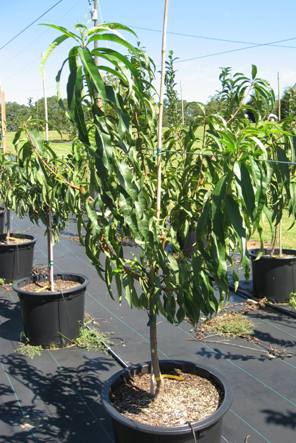 |
The Tomato Festival is July 7 this year. The entry form is online on the event page. It tells you what catagories of tomatoes we will be judging. |
Start planting your tomato seeds right now in order for them to be ready to plant in the garden after the last frost. Sow the seeds in flats indoors or in a greenhouse in a sterile soil mix, such as Pro-mix or Fafard. Make furrows with a pencil about 1/8" deep in the damp soil mix and drop seeds in. Cover with the soil, making sure that the seeds make direct contact with the soil. Place the container in a warm place about 75 to 80 degrees. Germination should take place in 5 to 10 days. As soon as the seeds emerge it is important to provide very strong light such as a very sunny window or florescent bulb. Once the true leaves have emerged it is time to transplant the tomatoes to a larger container. When the weather has warmed up and the night temperatures are above 55 degrees it is time to set out your plants. Harden off your seedlings by moving them out in the sun for a couple of hours at first and gradually increasing the time over a week so they are in full sun. Hardening off your seedlings helps to prevent transplant shock. Shelley has started about 38 different kinds of heirloom and new varieties of tomatoes along with many new vegetable varities. They should be ready to sale about the middle of March. If you would like to try lots of different tomatoes this would be the way to go. |
| Don't forget to feed the birds. Many plants that set berries make food for birds during the cold winter months. One in particular is Ilex verticillata "Winter Red". Native to North America, 40 species of wild birds are known to eat the berries including bluebirds, brown thrashers, cardinals, mocking birds and robins. In order for Winter Red to have berries it must be pollinated by Southern Gentlemen. |
| Consider forcing some branches to bloom to lighten up your sprits on dreary winter days. Place the stems in water and they will bloom in 2 to 3 weeks. For the best results, change the water and cut an inch from each stem every 3 to 4 days. Flowering quince, forsythia and apple blossoms work very well. |
